Features
Preserving Florida’s History
Researchers at USF St. Petersburg are working to digitize a treasure trove of Spanish documents that shed light on Florida’s past in St. Augustine.
| USF St. Petersburg
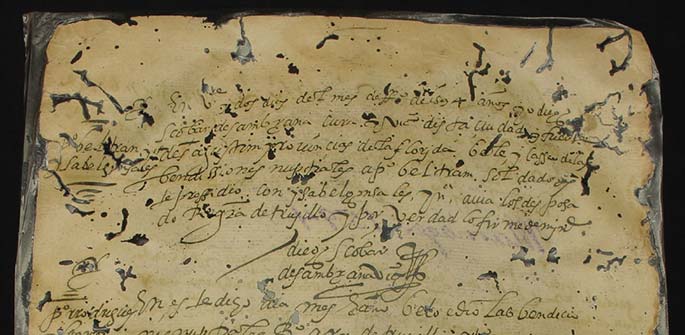
Hand-written documents like this entry dated Feb. 22, 1594, detail life in the early days of St. Augustine. The document records the marriage of a soldier of St. Augustine, Pedro Beltran, to a baptized Indian woman, Isabel Gonzales.
Photo by Arthur Tarratus
It is quiet in the archives, the silence broken only by the delicate crinkle of 400-year-old pages of parchment, the soft click of a digital camera, the occasional creak of an office chair.
Saber Gray sits at a table sorting the fragile, lacy pages by year and category — births, baptisms, marriages, deaths. She wears white cotton gloves to protect the pages and peers closely at each one as she goes. At a nearby table Arthur Tarratus methodically places one document after another into a box and photographs each page. Then he places one atop another with white-gloved hands until the stack reaches nearly a foot tall. And so it goes throughout the day, page after page.
“Tedious,” he says with a frown.
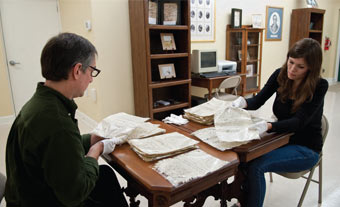
Photo by Aimee Blodgett | USF News
Gray and Tarratus are USF St. Petersburg graduate students in Florida Studies, working under the supervision of J. Michael Francis, the Hough Family Endowed Chair in Florida Studies, who sits at another table pondering a bound volume of documents from the late 1700s. The slow, deliberate nature of the work obscures their race against time.
Every day that passes is another day closer to the inevitable destruction of these priceless pages. Each document is encased in plastic from a 1939 preservation effort that protected the documents but also is slowly destroying each page, written with quill pen and dating back to 1594. A distinct smell of ammonia wafts from each box of documents as it is opened, the scent of dead bugs and ancient ink interacting with plastic.
They are spending this Saturday in the Historical Archives of the Catholic Diocese of St. Augustine at the Convent of the Sisters of St. Joseph’s in the heart of the city’s historic district. They are working with the Diocese to digitize the documents and put them online. The goal is to preserve them and make them accessible to scholars and the general public around the world.
“These are the earliest written documents from any region in the United States,” says Francis, one of the nation’s leading experts in the Spanish Colonial experience in the land Ponce de Leon named La Florida. The documents predate the Mayflower and the founding of Jamestown and are older than any documents created in the U.S. about the U.S. in the National Archives or the Library of Congress, he says. Each page is a loose thread in the history of St. Augustine, the nation’s oldest continuously occupied European city.
“I think it’s going to shed all kinds of light on individuals about whom we know very little,” Francis says. The project comes as Florida observes the 500th anniversary of Spain’s arrival to Florida with Ponce de Leon’s landing on the state’s east coast in April 1513. Events are planned around the state to mark the occasion. And in two years, St. Augustine will celebrate the 450th anniversary of its founding. The two anniversaries will bring heightened interest in Spain’s impact on Florida. The documents will help. “As we make this material available I think we will see a real renaissance in Florida studies,” Francis says.
But that will have to wait. For now the focus is on the tedious work of preservation, page by delicate page.
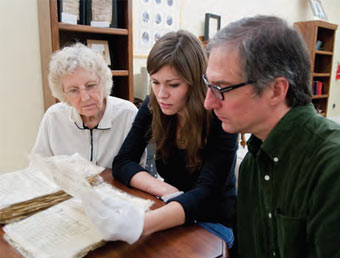
Sister Catherine Bitzer, Saber Gray and Arthur Tarratus.
Photo by Aimee Blodgett | USF News
Sister Catherine Bitzer, the archivist for the Diocese of St. Augustine who lives at the convent, personally oversees the work of Francis and his students. “She is extraordinarily protective of these documents,” Francis says. “I appreciate her for that. These documents are so sensitive.” The pages, dating from 1594 to the 1860s, have not always received such care, and most are riddled with holes from bugs and worms, giving them a lacy appearance. The parish was founded in 1565, but the first 29 years of records are missing. When the British took over St. Augustine in 1763, the records were shipped to Cuba, where they remained, largely forgotten, for more than a century. Augustin Verot, the first bishop of St. Augustine, discovered them in 1871 and sought to return them to St. Augustine. Most finally made it here in 1906; the last volume arrived in 1939. They total about 6,000 pages in all. Most are loose pages laminated at the National Archives and returned to the Cathedral Basilica of St. Augustine, where they remained, again largely forgotten, until the archive opened in 2007.
Francis credits Felipe J. Estevez, the current Bishop of St. Augustine, and Father Mike Morgan, chancellor of the Diocese of St. Augustine, for this latest preservation effort. “Everybody involved has been so passionate about the idea of making these materials accessible and sharing this chapter in American history that is virtually unknown,” Francis says. The diocese paid for the camera equipment and laptop computers used to digitize the documents.
Francis started the project after working with the diocese while teaching at the University of North Florida. A native of Canada, Francis earned a bachelor’s in history and a master’s in Colonial Latin American History from the University of Alberta and a doctorate in 16th Century Latin American history from Cambridge University. He got hooked on history after taking an undergraduate course in modern Latin America. “It completely transformed the way I thought about history,” he recalls. “It really taught me to look at the past in a new way: You can solve puzzles and raise questions.”
The documents his team is digitizing are pieces of the puzzle of the Spanish Colonial period in Florida, a time Francis considers neglected. Some fascinating insights already have emerged. As Gray puts it: “You can see the diversity of St. Augustine.” While Florida’s diversity today is well known, it is hardly a modern phenomenon. By the time the British founded Jamestown in 1607, St. Augustine already was home to 500 to 600 people — not just Spanish, but French, Flemish, Irish, Portuguese, German, Caribbeans, Native-Americans, and freed and enslaved Africans.
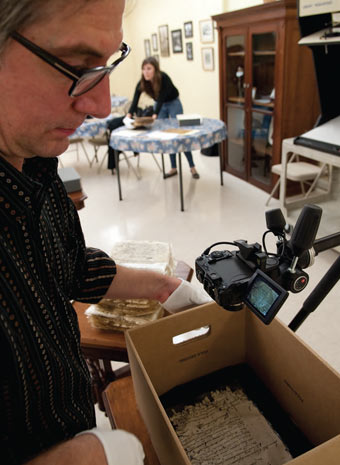
Gray sorts records while Tarratus records each document with digital photography.
Photo by Aimee Blodgett | USF News
The documents also provide a new perspective on slavery. St. Augustine was a magnet for runaway slaves and nearby Ft. Mose (pronounced Moh-Say), founded in 1738, was the first settlement of free blacks in the United States. Runaway slaves could obtain their freedom by swearing allegiance to Spain and being baptized in the Catholic Church. So the first “underground railroad” ran south and ended in St. Augustine. The year after the Civil War ended, the convent was founded to educate the area’s large population of freed blacks.
All of that history and more is contained in these documents. Together with documents housed in Spain and elsewhere, historians will be able to weave a rich, historical narrative. That task will be made much easier once the documents are digitized and put online. They are actually easier to read online because they can be magnified and software can smooth any irregularities. And scholars won’t have to travel to St. Augustine to study.
Examining the pages takes a special skill. They are written in a form of Spanish unique to the period, as is the handwriting. Gray and Tarratus have been studying 16th Century Spanish paleography under Francis for years and “are part of a handful in the country who can do this project,’’ says Francis. They also received specialized training in digitizing historical documents, led by Jane Landers, professor of history at Vanderbilt University, who has worked on similar projects in Africa, Colombia and Cuba and was familiar with the documents.
With so many fragile pages to sort and digitize, and only weekends to do the work, it’s important the team stays focused. Still, it’s easy for Francis and his students to get distracted by the individual stories the documents tell. “You all but feel like you’re growing along with them,” Tarratus says.
On a warm Saturday afternoon in January, Francis is immersed in a bound volume of baptismal records of blacks, both freed and enslaved. One page shows the baptism of two slaves named Feliciana, 6, and Sara, 3, on April 9, 1790. Both were “baptized in solemn urgency’’ on the banks of the St. Johns River in the house of their owner, Joseph Mills. Their ages and the urgency suggest the girls were thought to be deathly ill. Death records could confirm if they died soon after. Other records could shed light on their parents, listed in the documents as Monday and Carlotta. The records suggest the parish priest was making the rounds of local plantations, baptizing slaves as he went. Francis is enthralled at the possibilities.
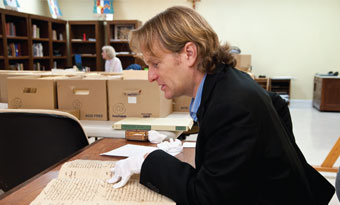
J. Michael Francis, the Hough Family Endowed Chair in Florida Studies at USF St. Petersburg, is one of the nation’s leading experts on the Spanish Colonial experience in Florida.
Photo by Aimee Blodgett | USF News
“This is why I couldn’t do this,” Francis says of the work that Gray and Tarratus are doing. “It would just go on and on.”
And they have to keep moving.
“OK!” Gray says triumphantly. “Box 13 is sorted. Wahoo!” It’s the last box and will move over to Tarratus for photographing. Next up: 17 bound books like the one Francis is studying. That will be trickier to do and they discuss ways of setting up the camera to capture full pages.
They have been working since September and hope to finish sometime in March. All the documents will then be placed on Vanderbilt University’s endangered archives site (http://www.vanderbilt.edu/esss/). Someday a scholar in Spain or another in New York City might use the documents to connect the dots of a narrative already being built from other records housed there.
“I don’t think we know just yet how important this material will be until scholars start to pore over them,” Francis says. “Then we’ll see the treasures that they are. I have no doubt that these will enhance our knowledge of this place.”